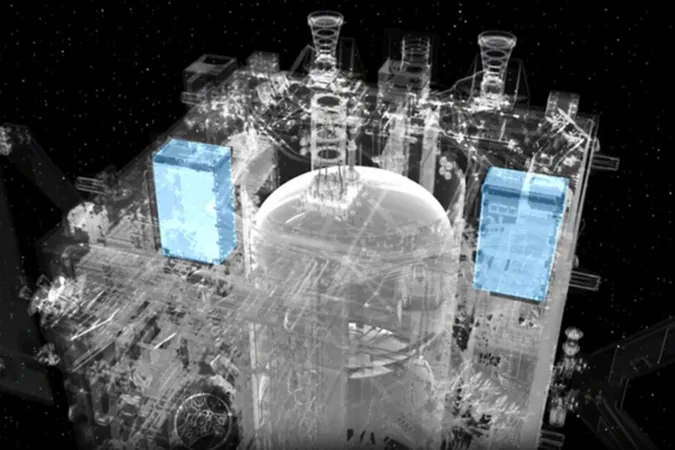
Groundbreaking Communication from Hera Mission's CubeSats: A New Era in Planetary Defense!
2024-10-28
Author: John Tan
Historic Milestone in Space Exploration
In a historic milestone for space exploration, two CubeSat passengers aboard the European Space Agency (ESA)'s Hera mission have successfully communicated with Earth for the first time, confirming their readiness for the mission ahead. This significant operation marks the first activation of ESA's CubeSats in deep space, showcasing cutting-edge technology designed for planetary defense and exploration.
Details of the Hera Mission
Launched on October 7, 2024, Hera is ESA's first planetary defense initiative aimed at studying Dimorphos, the asteroid whose orbit was altered by NASA's DART spacecraft in 2022. The groundbreaking DART impact represents a pivotal moment in human intervention with celestial bodies, which Hera aims to explore in detail.
CubeSats Objectives
The two CubeSats, Juventas and Milani—each measuring about the size of a shoebox—are poised to gather additional scientific data that will complement the data collected by their mothership, Hera. Juventas is designed to conduct the first-ever radar probing of an asteroid, while Milani will specialize in multispectral mineral prospecting, providing vital insights into the makeup of Dimorphos.
Significance of Activation
ESA's CubeSats Engineer, Franco Perez Lissi, described the activations as a crucial step in confirming the functionality of the CubeSats’ systems. "Each CubeSat was activated for approximately an hour in sequential sessions with Earth to perform essential system checks,” he stated. The duo is currently stowed within their Deep Space Deployers and will remain there until they are deployed closer to Dimorphos towards the end of 2026.
Operational Coordination
The commissioning sessions were conducted from ESA’s Operations Control Center in Darmstadt, Germany, with data also being processed at the European Space Security and Education Centre in Redu, Belgium. The intricate setup involved real-time collaboration between teams to ensure the smooth operation of both CubeSats, with signal transmission delays of up to 52 seconds for Milani due to the vast distances involved.
Validation of Communication Infrastructure
The successful checkouts not only verified the instruments on board but also validated the entire communication infrastructure, a feat that bodes well for the operational phase of the mission. Sylvain Lodiot, Hera Operations Manager, highlighted the importance of this verification, stating it paves the way for more complex future missions that will utilize similar technology.
Performance in Deep Space
Even in the harsh conditions of deep space, both CubeSats have performed admirably, maintaining stable voltages and temperatures despite exposure to cosmic rays. The engineers expressed their satisfaction with the electrical systems' performance, noting that both CubeSats preserved a high state of battery charge following their deep-space launch conditions.
Future Missions
Looking ahead, the CubeSats will be activated every two months during the journey to Dimorphos for routine checkouts, battery maintenance, and software updates. The data and information gathered through these missions will considerably enhance our understanding of asteroids and contribute significantly to ongoing planetary defense strategies.
Conclusion
The successful commissioning of these CubeSats signals not only a triumph for ESA but also a promising future for the integration of smaller spacecraft working alongside larger missions. What’s next on the horizon? ESA plans to build on this success with future missions, including the Ramses mission for planetary defense and the ambitious Comet Interceptor mission, which will further challenge our capabilities in space exploration.
Stay tuned as we follow the Hera mission and its valiant CubeSats on their groundbreaking journey to safeguard our planet and deepen our understanding of the Solar System!


 Brasil (PT)
Brasil (PT)
 Canada (EN)
Canada (EN)
 Chile (ES)
Chile (ES)
 Česko (CS)
Česko (CS)
 대한민국 (KO)
대한민국 (KO)
 España (ES)
España (ES)
 France (FR)
France (FR)
 Hong Kong (EN)
Hong Kong (EN)
 Italia (IT)
Italia (IT)
 日本 (JA)
日本 (JA)
 Magyarország (HU)
Magyarország (HU)
 Norge (NO)
Norge (NO)
 Polska (PL)
Polska (PL)
 Schweiz (DE)
Schweiz (DE)
 Singapore (EN)
Singapore (EN)
 Sverige (SV)
Sverige (SV)
 Suomi (FI)
Suomi (FI)
 Türkiye (TR)
Türkiye (TR)
 الإمارات العربية المتحدة (AR)
الإمارات العربية المتحدة (AR)